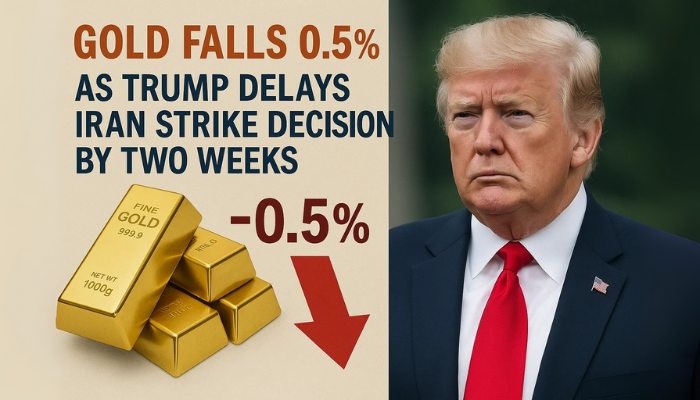Gold prices retreated in Asian trading on Friday as markets welcomed a temporary easing of geopolitical risk. The White House signaled that President Donald Trump will decide on potential U.S. military action against Iran within two weeks, offering short-term relief to anxious investors.
Spot gold declined 0.5% to $3,353.17 per ounce, while August futures slipped 1.1% to $3,369.40 by 00:58 ET (04:58 GMT). This decline follows a week of heightened tensions between Israel and Iran, which had previously driven safe-haven demand for bullion.
While the announcement offered some clarity, markets remain skeptical. Trump has previously used the “two weeks” timeline for major decisions—only to postpone them repeatedly.
Despite continued hostilities between Israel and Iran, investors began shifting back into risk assets, encouraged by signs that a U.S. strike is not imminent.
Dollar Strength, Fed Hawkishness Pressure Metals
Gold’s retreat was compounded by a resilient U.S. dollar, buoyed by the Federal Reserve’s hawkish stance earlier in the week. Although the greenback pulled back slightly on Friday, it was on track for a weekly gain, making dollar-denominated metals more expensive for foreign buyers.
This shift impacted other precious and industrial metals:
- Silver futures fell 1.6% to $35.765 per ounce
- Copper futures (LME) dropped 0.3% to $9,602.05 per ton
- U.S. copper futures declined 0.9% to $4.7650 per pound
The Fed’s firm tone on inflation and lack of rate cuts in the short term weighed on metals broadly, underscoring the market’s sensitivity to policy signals.
Platinum Cools After Four-Year High
Platinum prices also saw a pullback after a dramatic rally in recent weeks. Futures fell 1.5% to $1,282.75 per ounce, down from the four-year high hit during the prior session.
Despite the drop, platinum remains one of the strongest-performing metals this month. It is up 5.8% this week, supported by:
- Shrinking global inventories
- Increased demand from the industrial and auto sectors
- Speculative interest following bullish supply forecasts
Still, analysts remain cautious, questioning whether the rally is sustainable or merely driven by short-term momentum.
Conclusion:
Gold’s decline reflects a temporary calm in Middle East tensions and a stronger dollar. But with Trump’s decision still pending and the Israel-Iran conflict unresolved, volatility in metal markets is likely to persist.


